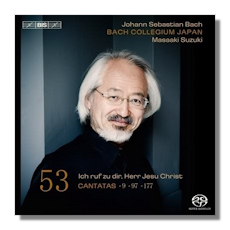
The Internet's Premier Classical Music Source
Related Links
- Bach Reviews
- Latest Reviews
- More Reviews
-
By Composer
-
Collections
DVD & Blu-ray
Books
Concert Reviews
Articles/Interviews
Software
Audio
Search Amazon
Recommended Links
Site News
 SACD Review
SACD Review
Johann Sebastian Bach

Cantatas, Volume 53
- In allen meinen Taten, BWV 97
- Ich ruf zu dir, Herr Jesu Christ, BWV 177
- Es ist das Heil uns kommen her, BWV 9
Hana Blazikova, soprano
Robin Blaze, countertenor
Gerd Türk, tenor
Peter Kooy, bass
Bach Collegium Japan/Masaaki Suzuki
BIS SACD-1991 Hybrid Multichannel
In 2012 Classical Net considered the first 50 volumes in the Bach cantata cycle under Masaaki Suzuki with the Bach Collegium Japan and soloists on BIS. It was found to be as serious a contender for your attention as those by Gardiner on SDG, Koopman on Challenge and Rilling on Hännsler Classic. Here is the 53rd in this BIS cycle, now nearing its completion. It contains three of the cantatas which Bach wrote in the late 1730s; by that time the hectic pace of one-cantata-each-week was over and his three extant cycles were finished. Only 200 of many more to have been written have survived.
Those on this CD are: In allen meinen Taten, BWV 97; Ich ruf zu dir, Herr Jesu Christ, BWV 177 and Es ist das Heil uns kommen her, BWV 9. They exhibit several characteristics largely absent in the completed cycles as such. Bach displays a nascent interest in the elegance and simpler aims of the incoming style galant and empfindsamer Stil. A monophonic, less sculpted, orchestration. More transparent melodic lines (listen to the aria, "Ihm hab ich" [tr.8] from BWV 97, for instance). A renewed interest in instrumental color, particularly using low wind, high strings; and the two tessiture combined. Yet this music is not in any way pared down: the impact of the (opening) chorus is still evident; the depth of harmonic intensity still conveys Bach's confessional commitment through the cantata medium – follow the key changes of "Ich ruf zu dir" from BWV 177 [tr.10] to hear nuance and effect in equal measure, for example.
The impact of this freshness in approach by Bach is to some extent masked by the fact that all three of the cantatas on this CD are Chorale Cantatas with greater rhythmic regularity, a slightly more rhetorical melody, and a less dense texture and emphasis on a hymn-like feel in such a way, presumably, as could involve worshippers at St. Thomas (Leipzig) more fully. Indeed, the probable librettist for these works was Bach's colleague at the School, Andreas Stübel (1653-1725).
But Suzuki's music making is at no times either pedestrian or mundane. As with the other cantatas recorded for BIS in the cycle since 1995, there is a calm, a sense of measured peace in the Bach Collegium Japan's playing style; and a gentleness to the delivery of the soloists. But these do not represent slackness, relaxation or reticence. Nor half-hearted withdrawal from the challenges of maintaining consistency hand in hand with variety and freshness. Rather, a kind of emotional maturity and delicacy, which sees no need to suppress either excitement or enthusiasm.
The soloists in this set are on top form. They have a lot of work to do. Their own voices – like those of the chorus – are measured and urbane; yet full of feeling. There are times when the chorus seems a little too remotely recorded… the opening of BWV 9 [tr.15] for example. But by and large the singers not only perform well in themselves; they also have a true enough understanding of the "soul" of Bach's music to meld well with the chorus and orchestra. Similarly the solo instrumentalists in their wider context constantly hold your interest without ever drawing attention to themselves. No solo contribution risks overshadowing the others' work. Gerd Türk and Hana Blazikova sing with particular aplomb and are especially persuasive throughout.
The acoustic – of the relatively recently-completed (1981) Shoin Women's University Chapel in Kobe (Japan) is resonant but not intrusively so. It allows every syllable of soprano Blazikova's, countertenor Blaze's, tenor Türk and bass Kooy's articulation to make its full impact. In common with established practice by BIS, the recording quality is excellent… this is the only cycle currently completed which is available on SACD – and high bit-rate, lossless FLAC if you download all but the earliest volumes. The booklet is brief but informative. It contains texts in German and English. If you're already collecting this series, you'll of course want to add this. If you want a sampler, give it a try: these period instrument performances have a lot going for them.
Copyright © 2013, Mark Sealey





















